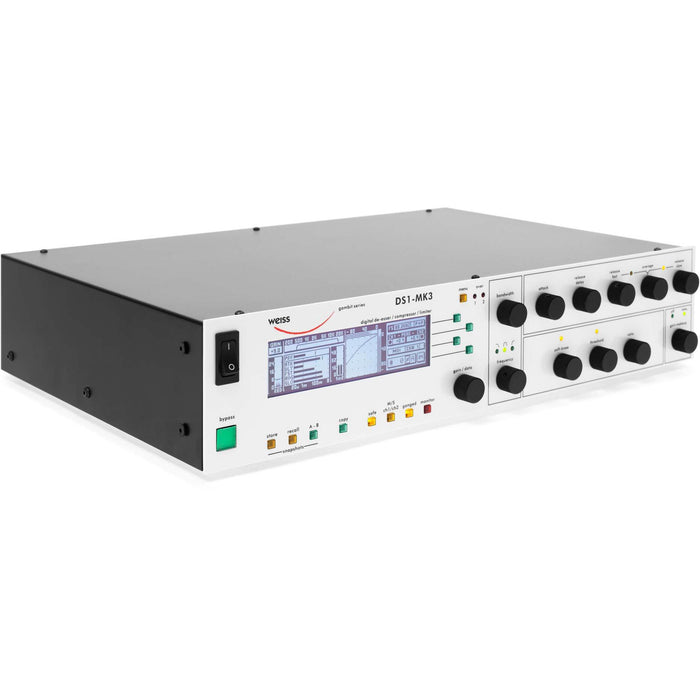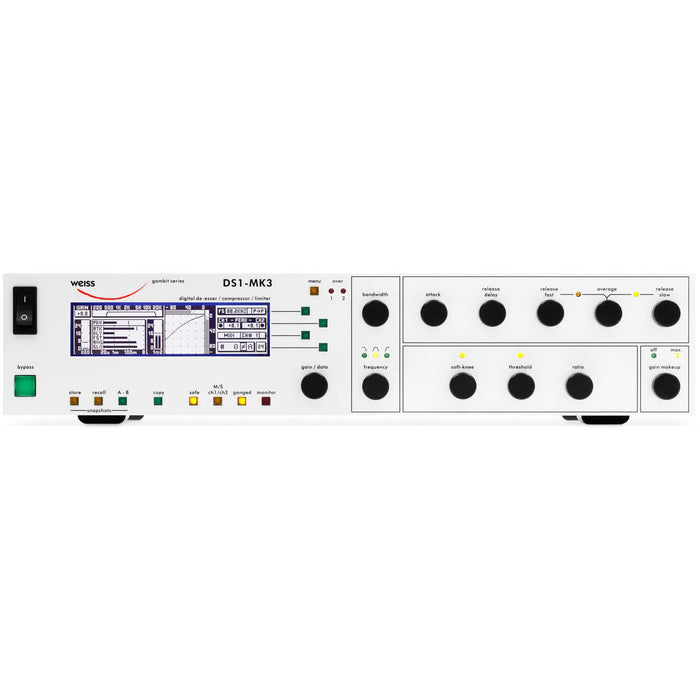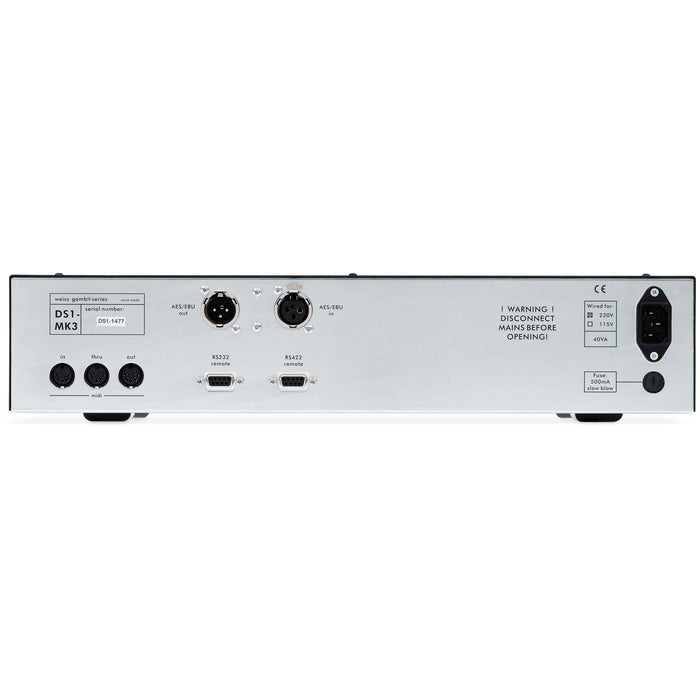
Weiss DS-1 MKIII De-Esser/Compressor/Limiter
Weiss DS-1 MKIII
The Weiss DS1-MK3 is the reference when it comes to digital mastering Compressors and De-Essers. An extremely versatile single band limiter/compressor with M/S mode and Parallel Compression facilities.
The Weiss 102 Series split band De-Esser was one of the mastering industry’s most highly praised digital product. With the DS1-MK3 the Weiss engineers have taken their de-esser design and combined it with the best features of the time proven 102 Series Dynamics Processors. The result is a stand alone digital Dynamics Processor with unparalleled performance and sonic integrity.
In de-esser mode the compression band is selectable as a lowpass, bandpass or highpass and extends the functionality beyond de-essing. The crossover filters are linear phase for the highest sonic quality. The full band dynamics processor with soft knee compressor and hard limiter is ideal for program loudness control.
Weiss DS-1 MKIII Features
Controls, display
There are a total of twelve knobs in order to almost have a "one knob per parameter" operation. The knobs are touch sensitive to switch the LCD to display the associated parameters. The LCD shows a graphical representation of the transfer function, input and output level meters and gain reduction meters. In addition there is a graphical indication of the split band characteristic. All parameters are shown in numerical format as well.
Snapshots, MIDI, metering
Other basic features are an A/B compare memory, a 128 position snapshot bank with two additional banks for back-up (can also be dumped/recovered via MIDI), over indicators, MIDI control for each parameter, an overall bypass switch and an overall gain control, a channel ganging switch.
Signal processing, connectivitiy
The internal processing is done at 88.2 or 96 kHz in a 40 Bit floating-point format. 44.1 or 48 kHz input signals are up- and down-sampled accordingly. The side chain is up-sampled for more precise peak detection. The output can be POW-R dithered to 16, 20 or 24 Bits. The DS1-MK3 can be set such that the unit is Bit transparent as long as there is no gain-reduction happening. This is the case even if the split-band filter is enabled. The digital input/output are in AES/EBU format on XLR connectors.
Split band filter
The split band filter is a linear phase design and can be switched to lowpass, bandpass, highpass or bypass characteristic. The center frequency of the filter can be set to very low frequencies as well, allowing to process bass instruments.
Threshold, ratio
The threshold parameter covers a huge range, which is useful for settings with small ratio values and very low threshold values for subtle compression over the whole level range. The ratio parameter can be set to values below one to up about 1000. Thus the DS1-MK3 can be used for upward expansion as well. The soft knee parameter allows to soften the transition between the linear and non-linear portions of the transfer curve.
Timing
Plenty of timing parameters allow for a wide range of applications. Attack, release and release delay parameters are there. The release portion can be set to a semi-automatic mode with three timing parameters controlling it. The preview delay controls the look-ahead time for the side-chain and finally the overall delay of the whole DS1-MK3 unit can be specified in seconds and also in video frames at various frame rates.
M/S mode, parallel compression
The DS1-MK3 can be switched to M/S mode which is especially useful for e.g. de-essing the voice of a singer. Thus the two channels can be set completely independent from each other, a feature which usually is required in M/S mode, but can also be useful in L/R mode when the two channels need different treatment. The side-chains can be linked or un-linked as required. A very useful feature is the so-called parallel compression which adds the input signal to the output signal. The effect is that lower levels are raised while higher levels are left alone. This makes for the least intrusive treatment with the least artifacts.
Level detection, peak limiter
The level detection in the side-chain can be switched between peak detection and RMS detection. After the main compressor section of the DS1-MK3 there is an additional peak limiter inserted. This limiter is meant to catch occasional peaks. It can be switched on/off and the audio level into that peak limiter can be set, allowing for just the right amount of additional limiting.
Gains
Gains in the DS1-MK3 include an overall output gain at the very end of the processing chain. Then a gain just ahead of the safety limiter for driving the limiter as mentioned above. The make-up gain can be set to automatic for the highest output level with any setting or can be changed manually.
Split-band filter monitor
The Monitor key allows to listen to the portion filtered by the split-band filter. A useful feature e.g. for zooming in on sibilances for de-essing.
Factory presets
The DS1-MK3 comes with several factory presets for various typical tasks. Most of the factory presets have been programmed by Mr. Bob Katz of Digital Domain Mastering.
Specifications
Power
- Mains voltage: 115 V or 230 V with voltage selector
- Fuse rating: 500 mA slow blow
- Power consumption: 40 VA max.
Size
- Depth: 30 cm
- Width: 43,3 cm (19")
- Height: 8,8 cm (2HU)
AES/EBU Input
- Sampling frequencies: 44.1 kHz, 48 kHz, 88.2 kHz, 96 kHz
- Maximum input word-length: 24 Bits
- Channel Status Data: Input accepts professional or consumer format
- Connector: XLR female
AES/EBU Output
- Sampling frequencies: 44.1 kHz, 48 kHz, 88.2 kHz, 96 kHz (always the same as the input)
- Output word-length: 24 Bits
- Connector: XLR male
AES/EBU Channel Status Data
The DS1 allows to convert the incoming Channel Status Data as follows:
- From Consumer to Professional
- From Professional to Consumer
- Transparent mode, i.e. Channel Status Data is fed forward to the output without any conversion (one exception, see below)
Overload
- Number of consecutive over-samples to cause “over” display: 1…16 selectable
Peak Meters
- Peak meters timing for compressor input and output stage adhere to AES recommendations.
Dither:
- Dithering algorithms are implemented using the POW-R set of algorithms, i.e. POW-R #1, POW-R #2, POW-R #3
MIDI Remote Control Protocol
- All parameters are remote controllable. Each parameter has its corresponding MIDI controller number. According to the different parameters, the controllers are limited in their range. Invalid values are replaced by the maximum allowable values. Details can be found in the DS1-MK3 manual.


